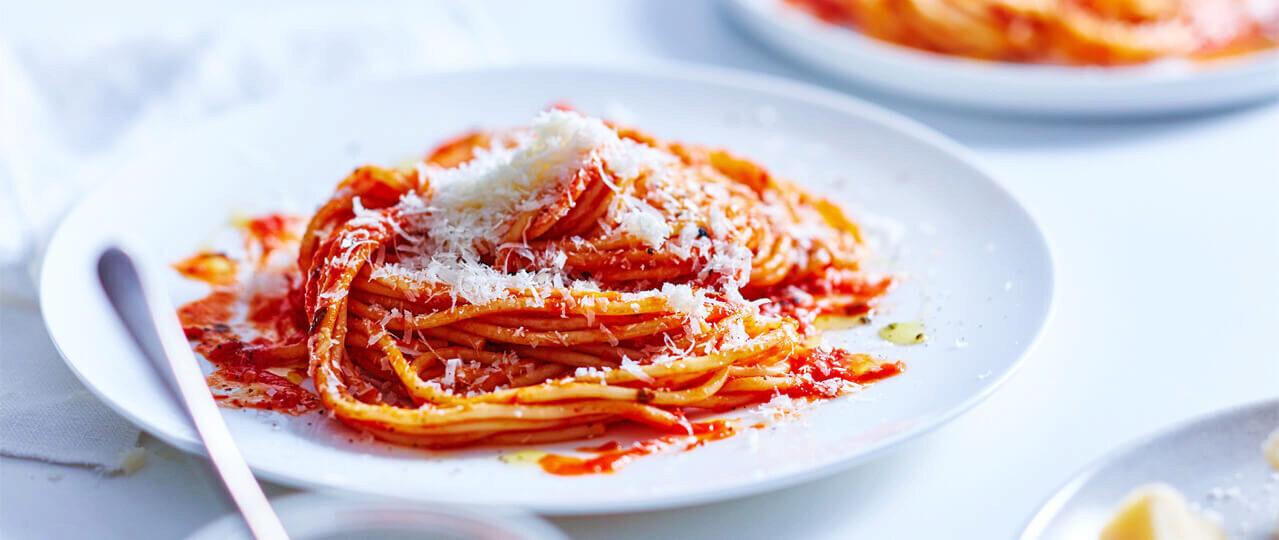

Stir well and boil the pasta, following the instructions on the back on the package, until almost but not quite al dente. Meanwhile, add the 2 tablespoons of salt and the pasta to the pot of water. Bring the mixture to a boil and simmer, stirring occasionally, for 20 minutes. Add the sausage and cook, breaking it up with a spoon and stirring, until the sausage is just cooked through, about 5 minutes.Īdd the tomatoes and 1 teaspoon of salt. Add the garlic, and cook, stirring, for 1 minute. Add the onion and cook, stirring occasionally, until softened, about 5 minutes. Meanwhile, heat the oil in a large skillet over medium heat. In a large saucepan or stockpot, bring 6 quarts of water to a boil.
Aldente pasta plus#
¾ pound loose sweet or hot Italian sausageĢ8-ounce can crushed tomatoes (preferably fire-roasted)Ģ tablespoons plus 1 teaspoon kosher salt, dividedģ ounces finely grated Parmesan cheese, divided Start to finish, one hour (30 minutes active). And a hearty pasta dish is just the thing to warm up a cold and wintry night.įusilli with Italian Sausage, Peas and Creamy Tomato Sauce The beauty of a pasta dish is that it rarely takes longer to throw together than the time it takes to boil the water and cook the pasta. And if your sauce is too thick, a few tablespoons of the cooking water you scooped out are just the thing. Now just add your pasta to the sauce, where it will finish cooking. That washes away the starch, which is what helps your sauce stick to the pasta. And don’t rinse your pasta after draining it. If there’s just a tiny bit of chewiness, it’s ready to be drained.īut before you drain it, scoop out and set aside a little of the cooking liquid. If it’s very chewy or tough, keep cooking it. All you have to do is spear a single piece and bite into it. It’s also important to check the tenderness of the pasta while it is cooking. Pasta should never wait for the sauce (once cooked, it doesn’t improve with age), so don’t start cooking it until your sauce is either well along or finished.įor cooking times, read the packaging and follow the suggested times. The pasta will end up oily, and the sauce will just slide off. And by the way, do not add oil to the water. If you’re boiling long strands, push them down gently in the middle to make sure the ends are submerged, too. For every 3 quarts of water, you’ll need 1 tablespoon of kosher salt.Īfter adding the pasta to the boiling water, give it a stir or two (and that should be enough). For 1 pound of pasta, you’ll want to boil 6 quarts of water (though 4 quarts will do if you don’t have a pot large enough). This prevents the pasta from sticking and mostly eliminates the need to stir during cooking. So let’s cover the basics of pasta cooking, regardless of variety. Of course, since pasta shapes, sizes and thicknesses vary widely, the proper cooking time for each pasta variety also varies. What you’re aiming for is al dente, Italian for “to the tooth.” It’s just a way of saying that properly cooked pasta is tender all the way through, but still ever so slightly firm to the bite. Undercook it and the pasta is chalky and tough. Whichever type you’re cooking, you want to make sure you cook your pasta properly. And pasta boasting nooks and crannies - like fusilli - are perfect for sauces with bits of meat and vegetables. Tube-shaped pastas - such as penne, rigatoni and macaroni - team up well with chunky sauces. Pastas in long strands - including spaghetti and linguine - are best paired with smoother sauces. Pasta comes in all sizes and shapes, all of them designed with a purpose. It’s the base of a zillion easy-to-make weeknight meals and the friendly playmate of 2 zillion ingredients, including leftovers. What’s the one ingredient you should always have in your cupboard? Dried pasta, of course. Digital Replica Edition Home Page Close Menu


 0 kommentar(er)
0 kommentar(er)
